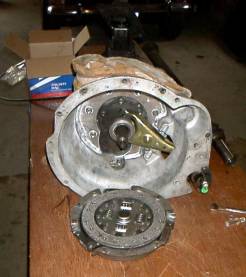by Paul Almjeld in the September 2000 RootesReview:
For some time now I have been interested in reducing the number of rpm’s required to run at contemporary highway speeds. Like many other Alpine owners, my first choice was to install an overdrive unit. After searching unsuccessfully in the upper Midwest for an overdrive transmission, I decided to replace the 4-speed Alpine tranny with a 5-speed from some other vehicle.
While attending the most recent SUNI convention in Montana in July, 1999, I spoke with several other owners about the project. One of them suggested using a Toyota 5-speed with the Alpine. The Toyota 5 speed box is readily available and comes in both the Corolla and Supra versions. The Supra box is very durable and will handle a significant amount of horsepower. There are at least three alternative gearings available, with the . 85 and . 86 final ratio the most common. There is also a . 783 gearbox version. While at the convention I also heard about a company that manufactured conversion kits to match the Toyota gearbox to a variety of engines.
After a few hours of searching on the internet I located a web site for Conversion Components, Ltd. In New Zealand. Their web site information indicated they had available a kit for mating a Toyota 5-speed to Sunbeam engines. I contacted them and, after several months of correspondence, decided to purchase their kit. I ordered only the conversion kit. It came supplied with a custom bell housing, clutch pressure plate, clutch disk, throwout fork, throw out bearing, new pilot bearing and pilot bearing bushing, speedometer cable and all necessary fasteners. From a local recycler I bought a 5-I I and speedometer cable. I bought 5-speed Celica transmission with a .783 final drive ratio from a local recycler.
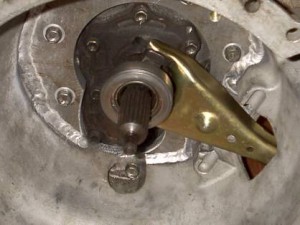
to a 3/4″ piece of aluminum plate.
The plate, which attaches to the tranny,
is drilled and machined to fit.
I removed the engine and transmission from my Alpine in order to more easily work on the project. For the most part I found the conversion process to be quite easy. The kit is well designed and is essentially a “bolt on” project. I made few changes to the kit as supplied, but did have to adjust the length of the bolt that acts as the pivot point for the new throw out fork. The length, as supplied, was too short to allow the clutch to be completely released. Fortunately, I checked the clutch action before I reinstalled the engine and transmission in the Alpine. After backing out the bolt about 3/8 of an inch the clutch action was correct. The bell housing used in my kit was from a Rapier. It was mated to a 3/4 inch aluminum plate which was machined and drilled in order to match up to the Toyota transmission.
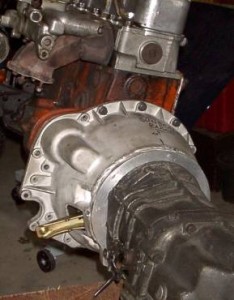
attached to the engine and transmission.
I found it quite easy to install
tranny with the engine out of the car.
Although it attaches to the 1725 cc engine with no difficulty, it did require the use of a Rapier clutch slave cylinder. Also, it required drilling two holes into the bell housing in order to attach both bolts of the support bracket that is connected to the oil pan and the rear of the bell housing. I would suggest to potential buyers of the kit that they specifically request a kit which uses an Alpine bell housing. That way the Alpine slave cylinder can be used. Also, it will have the correct bolt holes for attaching the bracket between the oil pan and the bell housing.
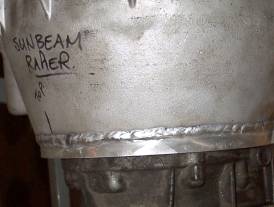
Sunbeam Rapier bell housing,
I had to find a clutch slave cylinder to fit.
I recommend using the
Alpine bell housing if possible.
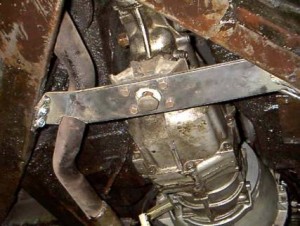
Other challenges I encountered were the result of an extremely tight fit in the driveshaft tunnel. In order to lift the transmission into place I had to remove a 3″ X 8″ piece from the front of the driveshaft tunnel where it meets the firewall and the floorboard on the driver’s side. I also had to enlarge the gear shift hole by about 3 inches. Conversion Components does supply an alternative gear shift position that should more closely match the Alpine. It would keep the shift lever about 3″ forward, though. (Since the Toyota lever is straight and not elbowed like the Alpine’s, it would be a longer reach to shift gears.)
I also had to drill an access hole through the tunnel in order to reach the transmission fluid filler plug. In order to determine the correct driveshaft length I made a couple of critical measurements and found the following: The total length of the Alpine transmission and bell housing from the front face of the housing to the rear output shaft was within a quarter inch of the total length of the new housing and 5-speed gearbox. I purchased a Celica driveshaft from a local recycler and took the Alpine and Toyota shafts to my local NAPA engine shop. They were able to cut the Alpine shaft and weld it to the Toyota yoke. With the transmission in place, I installed the new driveshaft and bolted it to the rear housing.
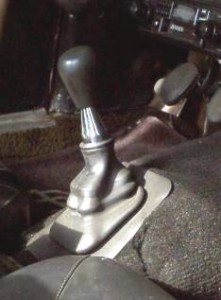
because of the location of the shift lever.
I removed the ashtray and fit a
piece of carpet. Beneath the carpet
I installed a heat and sound reflecting material.
With the transmission and driveshaft in place, I had to determine if the Alpine’s cross member could be used to support it. By using longer bolts and some heavy rubber cushioning I was able to successfully support the transmission with the original cross member. I found, though, after about 1500 miles of driving, that the amount of vibration transmitted into the car was just not satisfactory and decided to fabricate a more suitable support that would use the original rear mount from the Toyota. For the new cross member I used 1/4 inch, T-1 steel plate and bolted it to the X-frame. The amount of vibration has been significantly reduced.
The interior of the car required only minor modifications in order to accommodate the conversion. The ash tray had to be removed and new carpet pieces installed to cover the hole from the Alpine shift lever.
The last item, yet to be completely resolved, is that of the speedometer. The kit is complete with a speedometer cable that attaches to the Toyota transmission and the Alpine speedometer. It does require some adjustment, however, to indicate a reasonably correct speed. My short term solution was to use a speedometer head and cable from a Toyota Celica originally fitted with the same transmission as mine. I modified the dial face so that it would fit into the Alpine housing and installed it. It provides reasonably accurate mph readings. It does detract from the original appearance of the dash, however. My goal is to have the Alpine speedometer recalibrated to coincide with the Toyota tranny and restore the original appearance of the dash.
I have now driven about 2500 miles since I installed the new 5-speed. I am well satisfied with the results of the project. The 5th gear provides 11 mph for every 500 rpm, a big improvement over the stock 4th gear of the Alpine transmission. My total cost for the project, including the transmission, the driveshaft modification, rear cross member and the conversion kit was about $1000. Was it worth it? You bet!

